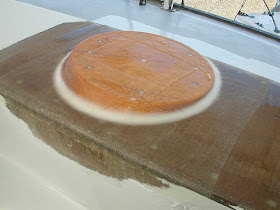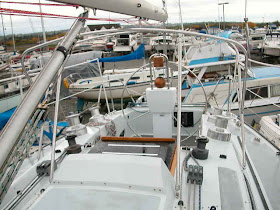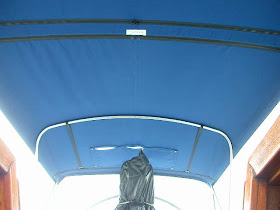The cockpit when I purchased the boat.
The motor instruments worked but slightly corroded. The hour clock down below had been disconnected fairly recent at 6103 hours. The connector was still a bright finish were the nut had been.
As an independent who likes sailing alone, I found the cockpit a pain to deal with. The traveller across the middle of the cockpit was hard on the shins trying to get over in a hurry to handle lines.
Going up on deck then back down was also clumsy and nothing to keep one from falling OB except safety lines (no hand grabs).
The motor shift levers were in a place that if I needed to shift or change speeds I had to bend over because I couldn't see ahead, if I were sitting, myself not being very tall.
The baked on coating on the aluminum winches were damage on most of them. The 4 big winches, 1 small winch and the jam cleats, all Japanese made (ROM), were all losing the coating, mostly from the PO's wrapping the stays around trying to pull in the mast after a de-masting. I don't know the details but the evidence was there. Also the 2 self-tailing Barients had a grove worn on the lower part of the capstan. The 2 Barlow's back aft, the aluminum bases were eroding away.
It wasn't until I installed a longer boom and new mainsail that I got around to doing something. So in spring of 2008 I started in on rebuilding the cockpit. Especially, after blowing a disk into my spinal cord the November before. Bending over or pulling something while bent over would put me in pain for longer then I cared.
So, I decided to raise the main winches straight up so I could stand and crank the winches. This turned out better then I expected.
After removing the winches and a bit of measuring I cut some frames and started the construction. I left the T-tranck in place as a referance
Every piece was epoxy glued in place and screwed with #10 screws.
And at this point I discovered that the port side of the boat was 1" longer then the stbd side. Was I pissed!!! The stringer came up short as well as the shock of being a crooked boat.
The outer edge of the stringer was precut to the same angle of the cabin and inset 3/4" for the thickness of the marine ply.
I put some slots in the outer stringers for a nice radius to flow with the cabin. Then filled the slots after it was in place. Again I had to grind away the nonskid.
The ply was glued and screwed in place to follow the stringer.
I added more internal stringers following the curvature of the cabin top and putting a slope on the aft end similar to the transom.
I ran a 45º angled strip along the outer base to create a radius.
Sunk the heads of the screws by over torquing, then filled.
Added the top section and faired in.
Views from the front........
You can see the pedestal, which I had installed a couple years earlier. I'll post on the later (another major project).
Finished up the cap aft, then filled and faired the corners.
In the mean time had the main winches recoated with and exhaust header ceramic. And set them up for reference and location.
Did some more fairing of corners, inside and out.
Filled in the radius along the bottom edge of the new ply, and faired in.
Made some angled base plates for the winches of mahogany. Then removed the T-track
Started in on epoxy/glass work using 2 layers of 10 oz, then 2 layers of 6 oz.
Adding one last coat of epoxy before sanding and paint
The glass extended all the way down to the cockpit deck and filled the radius.
The positioning of the winches and marking them for installation.
Adding a cut-out for an access port..........
Winch base glassed over......
I made angled washers for the SS backing plates so the screws don't get bent when tightening.
The position of the winches are different on opposite sides due to the RH wrap of the halyards in relation of the foot blocks on deck. Port side
Stbd side
Cut-outs from the inside and backing plates.
This was an advantage that I hadn't counted on. The long storage space for boat poles and brush handles. Along with other stuff.
After painting...........................
Another cut-out and water tight port/window for better ventilation.
Add the access port and winch bases..........
Winch capstans and port cover.............
Start the layout of the Treadmaster.................
Also added a small winch for the roller furling. The mic is for a Standard Horizon (RAM mic).
View from front...................................
Laying in the removable seats and ladders.
Brackets for seats & ladders...............
I cut down the width and height of the ladders so the seats could fit in the ladder brackets with the seat legs straight up/down. The legs tuck into the cockpit corner here.
View of the inside with a new wall board and hatches to access the new long storage space.
Move the hydraulics for back stay and mounted the traveller on top of the transom.
The old sheaves were having problems with chips and lubrication so I ordered new ones from Lewmar. Lewmar sent me these new sheaves but they were the wrong size and they wouldn't take them back. So I retro fit the traveler to take ball bearing sheaves, which are much better anyway!
Then I paid for a dodger and bimini from a local canvas maker
The side brackets was half ass so I made my own SS brackets to bolt thru the cabin that will not work loose.
It would take a 5# hammer to knock that loose. The 1/4" screw holding the tube end is the weak point. But there is enough metal that I can go larger if need be.

































































Hi there, your work is incredible! I've never seen anything like this cockpit. I have a couple questions as i want to do some fiberglass/repainting on my boat? Its my first boat so Im slightly lost on the fiberglass/gelcoat/paint aspect. What do you use to paint the top sides? How do you replace gelcoat? Also, how do you prep it? What do you use in areas where you need traction as far as awl grip? How are you getting such an incredibly smooth finish?
ReplyDeletePlease keep more posts coming! I check this site all the time for new stuff and thanks for doing such a good job documenting it.
Hi Sam,
DeleteThis boat was originally laid up on frames by hand so what gelcoat it had, has either been removed or painted over by now.
For small areas gelcoat can be brushed on and lightly sanded and polished but it's a pain. Large areas are generally sprayed on in a tented area and then usually needs to be rubbed out for whatever gloss one desires.
This vessel is all painted with Interlux Brightsides. The deck is the Interlux Interdeck mixed with a white and gray to match the Seattle gray cockpit and edgings.
Sanding/finishing I use an orbital sander with 100 grit. The paint sticks real good and levels out enough for the smooth gloss.
The paint is rolled on and tipped with a large fine brush. It takes two people to do a good job on the hull. One rolling the other tipping. Ya have to stay out of direct sun light and pick days with 75º F or less.
Del
Sam,
DeleteThe topsides are also painted with Interlux, but for the deck/nonskid I used the Interdeck series. They didn't have the Seattle Gray like what is used for the trim and cockpit, so I mixed a little gray with the white until I got a fairly close match.
I don't like white. In the sunny climates it's hard on the eyes, and the light gray (Seattle Gray) doesn't have but just a little heat absorption. Awl grip is a NZ brand of nonskid, which is pretty good from what I hear. It's just too course to suit me.
I haven't really put down much gelcoat except to repair some chips and cracks. But from what I understand, for large areas, it needs to be sprayed on just like paint and then rubbed out to a nice finish. I've only done small spots. Also one is not supposed to put gelcoat over epoxy.
Prepping for any coat is usually sanding then cleaning with a dry solvent (acetone or MEK) except a painted serface. For a painted surface one should use a paint thinner for cleaning. Acetone or MEK will dissolve paint.
This is great, do you use a foam brush or one with really fine bristles?
ReplyDelete